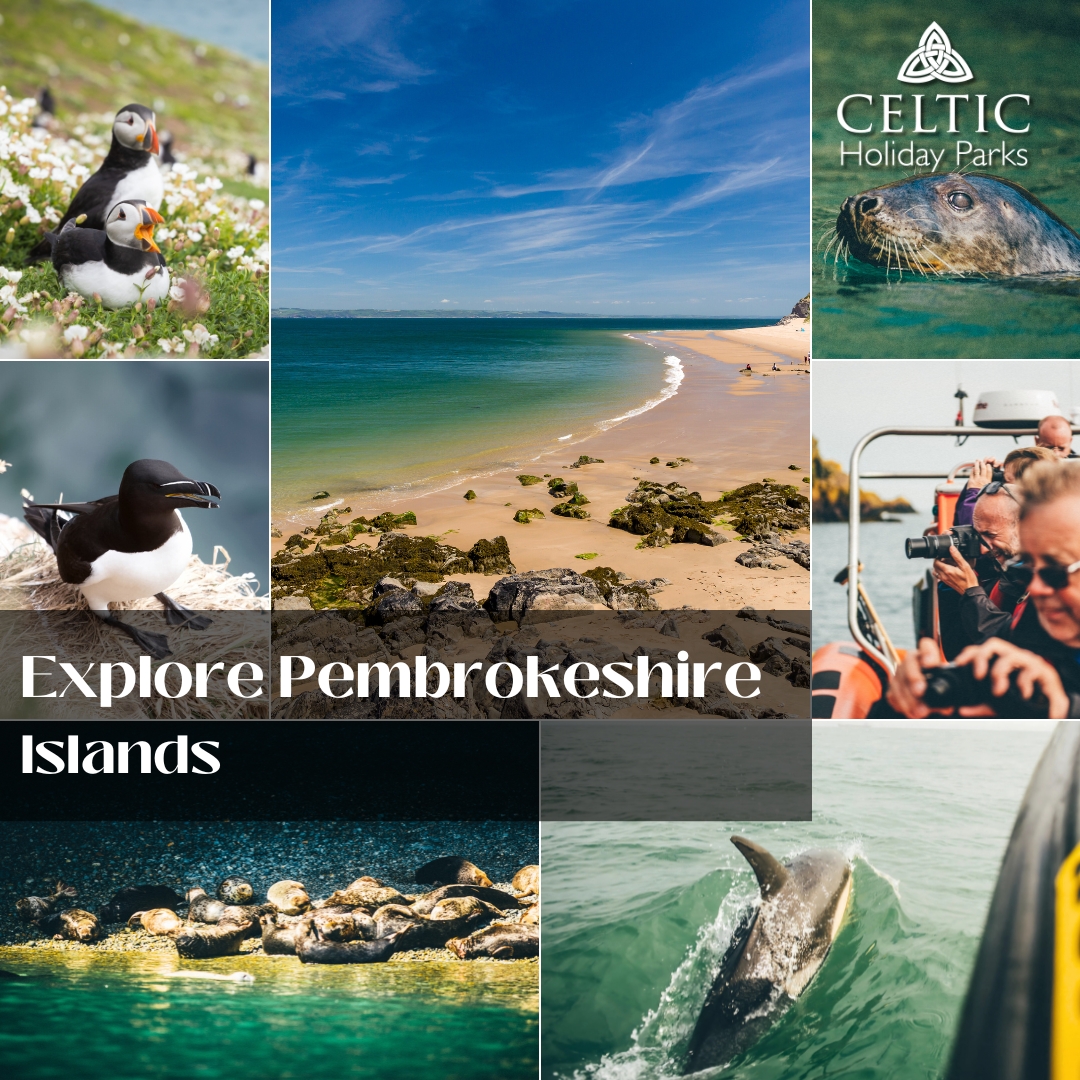Celtic Holiday Parks Limited - in Administration. The affairs, business and property of Celtic Holiday Parks Limited (“the Company”) are being managed by Alistair Wardell and Richard Lewis, who were appointed as Joint Administrators on 27 May 2025. The Joint Administrators act as agents of the Company and without personal liability. Alistair Wardell and Richard Lewis are authorised by the Insolvency Practitioners Association to act as insolvency practitioners.
C, V & A Pendleton (a firm) (the Partnership), trading as Croft Country Park – In Administration. The affairs, business and property of C, V & A Pendleton (a firm) are being managed by Alistair Wardell and Richard Lewis, appointed as Joint Administrators on 23 June 2025. The Joint Administrators act as agents of the Partnership and without personal liability. Alistair Wardell and Richard Lewis are both authorised by the IPA to act as insolvency practitioners.
This Spring & Summer 2025
Explore Pembrokeshire: Islands

If you’re staying at Croft Country Park, you may have noticed that our caravans (all with hot tubs) are named after some of Pembrokeshire’s striking islands. In this article we’re going to give you some more information about them, including a bit of history and an overview of their resident wildlife!
Caldey Island
Welsh Name: Ynys Bŷr
An approximately 1.5 mile long island in Carmarthen Bay with a variety of religious buildings, museum, gift shop, lighthouse, and stunning sandy beach.
History: One of Britain’s holy islands with a recorded history stretching back over 1500 years, however human bones dating back to the middle stone age and several artefacts from the upper Palaeolithic period have been found in some of the caves.
A Celtic monastery was built during the 6th century, followed by Caldey Priory in the 12th century (which is now a Grade I listed building), and then Caldey Abbey in 1910.
The island is currently home to around 40 permanent residents, and a varying number of Reformed Cistercian monks who make chocolate, yoghurt, and perfume. Perfume critic Luca Turin called their lavender perfume “simply the best lavender soliflore on earth” (soliflore meaning the dominant scent of a specific flower).
Wildlife: Red Squirrels were introduced in 2016 with the current population reaching over 60. You can also find rare breed Soay Sheep, Black Swans, Golden Pheasants, and Peregrine Falcons among others.
Open dates: April - October
Days: Monday - Saturday (closed Sundays)
Price: (includes boat fare) £18 Adult | £10 Child | Dogs welcome
Location: Caldey Island, Tenby SA70 7UJ
How to get there: 20 min ferry from Tenby harbour, sailings every 20-30 mins
Link: https://www.visitpembrokeshire.com/attraction-listing/caldey-island
Stay in the Caldey at Croft Country Park: https://www.celticholidayparks.com/croft-country-park/caldey/
Ramsey Island
Welsh Name: Ynys Dewi
A roughly 2 mile long island off St Davids Heads with striking cliffs that can reach heights of up to 120m (400ft), home to an RSPB nature reserve, and the 4th largest island in Wales.
History: The island used to be part of Dewisland and was controlled by the bishops of St David’s from 1082, becoming a place of pilgrimage in the 12th century, with St Tyfanog’s Chapel standing until the 15th century.
It was also used for farming from the 14th century, with a lime kiln, corn mill and farmhouse noted in the 16th century. The kiln and mill were still being used until the early 20th century, but the farmhouse had become a ruin by the beginning of the 19th century. A new one was built not long after and is now Grade II listed.
Since the 1990s, a few surveys have been done which have uncovered evidence of prehistoric cairns, barrows, and field systems (among other things) which hint at human activity going back nearly 5000 years. A holy well and 9th century cemetery have also been discovered.
Wildlife: Ramsey is home to the most important Grey Seal breeding colony in southern Britain with over 400 pups born every Autumn, and is the best place in Wales to see Choughs (who are drawn to the island by a sizeable population of Dung Beetles). It’s also a breeding site for many other birds including Common Buzzards, Peregrines, Ravens, Manx Shearwaters, Razorbills, and Guillemots to name a few.
Open dates: 1st April - 31st October
Days: Saturday - Thursday (closed Fridays)
Price: (includes boat fare) £32 Adult | £27 Child | £22 Adult or Child RSPB Member
Location: Ramsey Island, St Davids SA62 6RS
How to get there: Ferry from St Justinian’s Lifeboat Station, 2 departures a day
Link: https://www.visitpembrokeshire.com/explore-pembrokeshire/wildlife-and-nature/ramsey-island
Stay in the Ramsey at Croft Country Park: https://www.celticholidayparks.com/croft-country-park/ramsey/
Skomer Island
Welsh Name: Ynys Sgomer
A 720 acre island and haven for wildlife in Jack Sound. It’s a nature reserve surrounded by a marine nature reserve, as well as a Site of Special Scientific Interest (SSSI) which aims to protect natural areas including their geology and wildlife, and a Special Protection Area (SPA) which aims to safeguard habitats or migratory or threatened species of birds.
History: Most of the island has been designated as an Ancient Monument, and you can find stone circles, standing stones, and remnants of prehistoric housing dating back to the bronze and iron ages across its rugged landscape.
Wildlife: Skomer has abundant wildlife, including a breeding population of Glow Worms and its own subset of Vole (called the Skomer Vole).
It’s also home to HALF the world’s population of Manx Shearwaters, as well as the largest Atlantic Puffin colony in southern Britain, plus a multitude of other birds including Eurasian Oystercatchers, European Storm Petrels, Short Eared Owls, Common Kestrels and Peregrine Falcons.
You can also frequently find Grey Seals, Common Dolphins and Harbour Porpoises in the surrounding waters.
Open dates: April - August | September on reduced schedule
Days: Tuesday - Sunday (closed Mondays)
Price: (includes boat fare) £44 Adult | £30 Child | FREE Under 2s
Location: Skomer Island, Marloes SA62 3BJ
How to get there: 15 min boat ride from Martin’s Haven, 5 sailings a day (87 steep steps upon landing, uneven footpaths)
Link: https://www.visitpembrokeshire.com/explore-pembrokeshire/wildlife-and-nature/skomer-island
Stay in the Skomer at Croft Country Park: https://www.celticholidayparks.com/croft-country-park/skomer-2-3/
Skokholm Island
Welsh Name: Ynys Sgogwm
History: There is evidence to suggest settlement going back several thousand years, potentially all the way back to the stone age.
It’s speculated that the island was named by Vikings, with Skokholm meaning ‘wooded island’ in Norse, however the island is completely treeless in the present day.
The island was purchased for £300 by William Philipps in the 17th century and was kept in the family for over 350 years, until it was sold to the Wildlife Trust and designated as a national nature reserve in 2008.
In 1933 it was the site of Britain’s first bird observatory, where the main function was the ringing and researching of resident and migrating birds.
Wildlife: Over the spring and summer you can find up to 5000 Puffins burrowing around the island, as well as thousands of Razorbills and Guillemots on the cliffs, and around 100 pairs of Fulmars. Throughout the year you can also find up to 20% of Europe’s population of Storm Petrels, and a share of the huge number of Manx Shearwaters that also nest on Skomer.
There are a number of Grey Seals regularly seen basking on the rocks and swimming in the waters around Skokholm, as well as frequent sightings of Harbour Porpoise, and Common, Bottlenose, and Risso’s Dolphins.
Location: Skokholm Island, Marloes SA62 3BL
How to get there: The island itself isn’t available for day trips, but there are a number of boat tours which take your around the waters
Link: https://www.visitpembrokeshire.com/explore-pembrokeshire/wildlife-and-nature/skokholm-island
Stay in the Skokholm Lodge at Croft Country Park: https://www.celticholidayparks.com/croft-country-park/skokholm-lodge/
St Margaret’s Island
Welsh Name: Ynys Farged
A publicly inaccessible 17 acre tidal island in Carmarthen Bay that separates from Caldey Island at high tide, sometimes called Little Caldey.
History: The island had a small chapel that is suggested to have been built in the 17th century, as well as extensive limestone quarry works and various associated buildings. The chapel was converted into lodgings for quarry workers in the 19th century, but the whole island was unfortunately abandoned by 1851 with the chapel and other buildings collapsing into ruin.
It has been leased by the Picton Castle Estate since 1950 and is now a designated Site of Special Scientific Interest (SSSI) which is a conservation designation aimed at protecting natural areas, including their geology and wildlife.
Wildlife: Home to the largest community of Cormorants in England and Wales, plus Kittiwakes, Guillemots, Razorbills, a small number of Puffins on the cliffs, and a variety of Gulls, among others.
Location: Northwest of Caldey Island, Tenby SA70 7UJ
How to get there: The island itself is inaccessible, but there are boat tours which take you around the waters
Link: https://www.pembrokeshirecoast.wales/things-to-do/pembrokeshires-islands/st-margarets/
Stay in the St Margaret’s Pod at Croft Country Park: https://www.celticholidayparks.com/croft-country-park/st-margarets-pod/
Thinking about a holiday in beautiful Pembrokeshire, Wales?
Explore accommodation with hot tubs at Celtic Holiday Parks: https://www.celticholidayparks.com/hot-tub-holidays/
Article by Chrissi Atkinson
Photos © Crown copyright (2022) Cymru Wales

